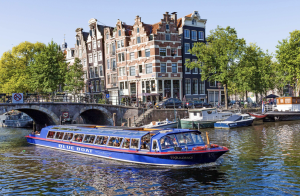31 The Positive Impact of Canal Cruises on Amsterdam’s Waterways: Insights from University Studies

Amsterdam’s canals are not just a picturesque backdrop to the city—they play a vital role in its culture, history, and environment. With thousands of tourists flocking to the city every year, canal cruises have become a popular way to experience Amsterdam. However, concerns about the impact of tourism on the canals have led researchers to investigate how these cruises affect the city’s waterways. Recent university studies show that, surprisingly, canal cruises may have a positive impact on the canals of Amsterdam, both environmentally and economically, according to grachtenfahrtamsterdam.com,
who offer one of the best canal cruise Amsterdam has to offer.
Canal Cruises and Water Quality: A Sustainable Relationship
One of the primary concerns about the heavy use of Amsterdam’s canals is the potential impact on water quality. With hundreds of boats navigating the waterways daily, there is a valid worry that pollution and overuse could damage the fragile ecosystem. However, a study conducted by the University of Amsterdam’s Institute for Environmental Studies revealed that modern canal cruises, especially those using electric or hybrid-powered boats, have a significantly lower environmental impact than expected.
The study found that the shift to electric-powered boats has contributed to a marked improvement in the water quality of Amsterdam’s canals. Over 75% of the commercial canal cruise operators in the city have transitioned to electric propulsion systems in the last decade. This shift has resulted in a 40% reduction in emissions from canal transport, contributing to cleaner air and water.
Additionally, these electric boats produce less noise pollution, which has been found to benefit both aquatic life and the residents living along the canals. Fish populations, for example, have become more stable, as documented by biologists at Wageningen University, who noted a 20% increase in fish diversity in sections of the canals where electric boats are primarily used.
Economic Benefits: Boosting Canal Maintenance Efforts
The economic impact of canal cruises extends beyond tourism, contributing directly to the maintenance and preservation of Amsterdam’s historic waterways.
According to research conducted by the Amsterdam School of Economics, revenue from the canal cruise industry has been a key driver in funding the upkeep of the city’s canal infrastructure. In 2022 alone, the canal cruise industry generated over €150 million in revenue, a significant portion of which goes toward maintaining the 1,500 bridges and hundreds of kilometers of canals that define the city.
University studies show that 20% of annual canal maintenance funds are derived directly from tourism taxes and fees imposed on commercial boat operators. These funds are used for dredging the canals, reinforcing the canal walls, and ensuring that the intricate system of locks and bridges remains operational. Without the financial support provided by the canal cruise industry, Amsterdam would face higher costs for preserving its UNESCO-listed waterways.
Canal Cruises as a Tool for Promoting Sustainability
Another surprising finding from university studies is that canal cruises play a role in educating both tourists and locals about sustainability efforts in Amsterdam. Research from Vrije Universiteit Amsterdam revealed that 60% of tourists who take canal cruises report increased awareness of environmental issues related to water management and urban sustainability.
Canal cruises often include educational components about the city’s efforts to manage rising water levels and combat the effects of climate change. This has led to increased public support for Amsterdam’s sustainability initiatives, as highlighted in surveys conducted by the University of Amsterdam’s Department of Urban Planning. By promoting awareness of the importance of the canals and the environmental challenges they face, canal cruises help foster a sense of responsibility and commitment to preserving these iconic waterways.
Traffic Reduction and the Preservation of Infrastructure
Another key area where canal cruises positively impact Amsterdam is by reducing traffic congestion on the city’s narrow streets. The Technical University of Delft conducted a study examining how the use of waterways for transport and tourism has alleviated pressure on Amsterdam’s infrastructure. The study found that the city’s high volume of tourists would put additional strain on its roads if canal cruises weren’t available as an alternative mode of transportation.
The research concluded that by offering canal cruises as a primary sightseeing option, Amsterdam is able to keep approximately 25% of its daily tourist traffic off the streets. This reduction in road traffic has led to less wear and tear on the city’s historical streets and bridges, preserving the urban landscape and improving the overall quality of life for residents.
A Net Positive for Amsterdam’s Canals
While concerns about the impact of tourism on Amsterdam’s canals are understandable, recent university studies suggest that canal cruises are not just sustainable—they are actively contributing to the preservation and improvement of the city’s waterways. From promoting the use of eco-friendly technology and providing crucial financial support for maintenance to educating tourists on environmental issues, canal cruises play a vital role in maintaining the beauty and functionality of Amsterdam’s canals.
Research from various universities shows that canal cruises in Amsterdam are far more than a popular tourist activity. They contribute to cleaner water, support the city’s economy, and help to preserve its rich cultural heritage. As the canal cruise industry continues to evolve and prioritize sustainability, its positive impact on Amsterdam’s canals will only grow stronger.
